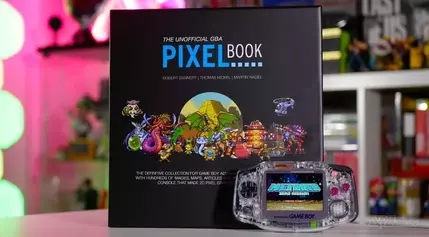When we take a moment to reflect, it becomes clear that the Game Boy Advance holds a special place in gaming history. Arriving in 2001, it emerged as the last truly dedicated 2D gaming platform. By 2004, with the arrival of its successor, the DS, the shift towards 3D in portable consoles was well underway. Yet, the GBA was a high point for 2D art, where it could truly flourish and evolve.Discovering the GBA Pixel Book
Created by Robert Bannert, Thomas Nickel, and Martin Nagel, the GBA Pixel Book is a visual masterpiece. Originally published in Germany by Elektrospieler in 2023, it is now available in English thanks to Bitmap Books. Just like its predecessor, the SNES Pixel Book, this one is all about 2D art. The pages are filled with glorious pixel artwork from some of the console's most acclaimed releases, such as Fire Emblem, Golden Sun, Wario Ware, Metroid: Zero Mission, Castlevania: Aria of Sorrow, Final Fantasy Tactics Advance, Gunstar Super Heroes, Legend of Zelda: The Minish Cap, and many more.One of the most refreshing aspects is that the team didn't just focus on the most popular titles. A whole double-page spread is dedicated to Harry Potter and the Chamber of Secrets because Henk Nieborg worked on it and contributed amazing pixel art. Even some of the GBA's lesser-known releases get their due space because the art they showcase is noteworthy even after 20 years.The design and layout of each page evoke the feel of '90s magazines like CVG and Mean Machines, allowing the visuals to shine. It's almost impossible to look at a few pages without feeling the urge to dust off your GBA and see these graphics in motion. From a design perspective, it's a true visual feast.If we were to find a fault with the GBA Pixel Book, it would be the text. Clearly translated from the original German, it can sometimes seem a bit awkward. However, this is a common issue with localised books and doesn't detract too much from the overall experience. The writing does an excellent job of communicating the specialness of these games.Pixel art may not have died as predicted, and we can find amazing examples on modern machines. But back when the GBA was the go-to for gaming on the go, artists and developers had no choice but to embrace pixels. This is perhaps why the GBA is home to so many amazing 2D games, and this book is the most convincing evidence of that.Please note that some external links on this page are affiliate links, meaning if you click them and make a purchase, we may receive a small percentage of the sale. For more information, please read our FTC Disclosure.

